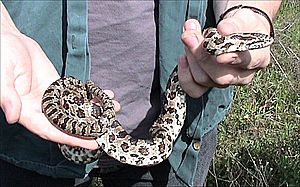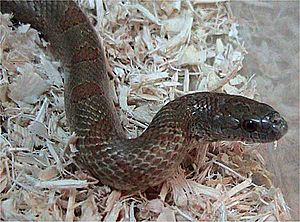Lampropeltis calligaster facts for kids
Quick facts for kids Lampropeltis calligaster |
|
|---|---|
 |
|
| Prairie kingsnake Lampropeltis calligaster calligaster |
|
| Conservation status | |
| Scientific classification | |
| Genus: |
Lampropeltis
|
| Species: |
calligaster
|
| Synonyms | |
The Lampropeltis calligaster is a type of snake commonly known as the prairie kingsnake or yellow-bellied kingsnake. It is a fascinating species of kingsnake found in many parts of the United States. These snakes are not dangerous to humans because they are nonvenomous.
Contents
Where They Live
Prairie kingsnakes live across the midwestern and southeastern United States. You can find them from states like Nebraska all the way to Maryland. Their range also stretches from Florida to Texas.
What They Look Like
These snakes are usually light brown or grey in color. They have darker blotches (spots) that can be dark grey, dark brown, or even reddish-brown along their bodies. Prairie kingsnakes can grow to be about 30 to 40 inches (76 to 102 cm) long.
Sometimes, their markings can fade, making them look almost solid brown. Young prairie kingsnakes, called juveniles, often have a brown stripe down their back. They also have two black spots behind their head and smaller black spots along the stripe.
It can be easy to confuse prairie kingsnakes with other snakes, like rat snakes. This is because rat snakes live in the same areas and can have similar markings.
How They Behave
Prairie kingsnakes like to live in open grassland areas. They prefer places with loose, dry soil, often near the edge of a forest. They also like to be close to a steady source of water.
Their main diet is rodents, like mice and rats. However, they will also eat lizards, frogs, and sometimes even other snakes.
These snakes are generally calm and not likely to bite. If they feel bothered, they might shake their tail. If they do this in dry leaves, it can sound a lot like a rattlesnake. They might also release a stinky musk if you handle them. When they feel threatened, they can flatten their bodies and appear to have white spots.
Where They Hide
Prairie kingsnakes are often hard to spot because they are quite secretive. They are often found in old, unused buildings. You might also find them hiding under logs, piles of debris, or inside hollow tree trunks. People usually don't see them unless they are actively looking for them.
Types of Prairie Kingsnakes
There are three different types, or subspecies, of the prairie kingsnake:
- Prairie kingsnake, L. c. calligaster
- South Florida mole kingsnake, L. c. occipitolineata
- Mole kingsnake or mole snake, L. c. rhombomaculata



